by Lisa Cooke | May 5, 2017 | 01 What's New, Digital Archives, Records & databases
Millions of New England vital records are among newly-published genealogy records online. So are English parish records, Irish Easter Rising records, Italian civil registrations, South African church records, and records for Georgia WWI soldiers and Louisiana women.
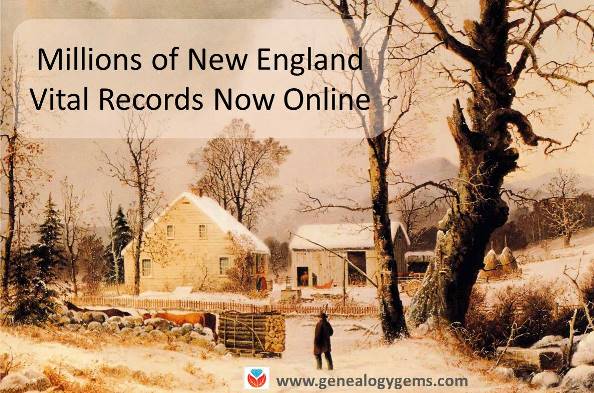
New online this week are millions of new genealogy records from around the world! First, we’ll feature these (mostly) free vital records collections for New England states–but keep scrolling. We’ve got records to mention for other parts of the U.S., as well as England, Ireland, Italy, and South Africa.
New England Vital Records
New England vital records online got a BIG bump this week with the following additions:
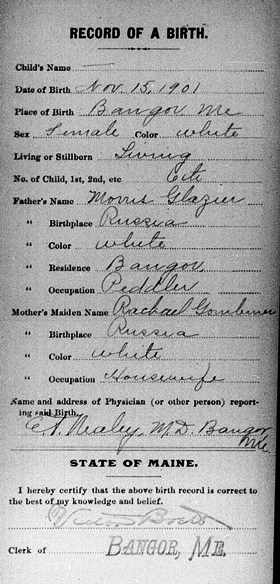
Sample image from “Maine Vital Records, 1670-1921.” Database with images. FamilySearch. http://FamilySearch.org : 2 May 2017. Citing Division of Vital Statistics. State Board of Health, Augusta. Click to view.
Connecticut. More than 755,000 indexed names have been added to FamilySearch.org’s free collection, Connecticut Marriages, 1640-1939. This hybrid index/image collection has this note: “We have legal rights to publish most of the images associated with these records; however, there are a few records that will not have an accompanying image available for view.”
Maine. FamilySearch.org has added nearly a half million indexed names to its collection of Maine Vital Records, 1670-1921. According to the site, the collection is comprised of a “name index and images of birth, marriage, and death returns acquired from the State Board of Health, Division of Vital Statistics and the state archives.”
Massachusetts: New images have been added to the New England Historic Genealogical Society’s collection for the Roman Catholic Archdiocese of Boston, 1789-1900. The update includes the following volumes: Immaculate Conception (Salem), St. Mary (Salem), and Sacred Heart (Roslindale).
Rhode Island. FamilySearch has added over a half million new indexed names and 30,000 digital images to its free collection, Rhode Island – Vital records. These are described as “Certificates and registers of births, 1846-1898, 1901-1903, marriages 1901-1903 and deaths, 1901-1953 acquired from the State Archives in Providence.”
Other new and updated records in the US include:
- Newspapers – Baltimore MD and Hartford CT. Newspapers.com has added issues for two major papers: the Baltimore Sun (1837-2017) and the Hartford Courant (1764–2017). (With a Newspapers.com Basic subscription, you can access issues of these papers through 1922; or, with a Publisher Extra subscription, access those early years and additional issues from 1923 onward.)
- Georgia. A memorial book for Georgia soldiers who served in World War I is being updated to include the names of African-Americans who served. “Due to the social and racial conditions of the time, this Memorial Book contains the information for only white soldiers,” explains the database landing page on the free United States World War I Centennial Commission website. “The current project is rectifying this by adding information for Georgia’s African-American personnel that also died in service. Further, we are adding names found on WWI monuments and plaques that are missing from the original Memorial Book….As missing names are determined and documented, they will be added” We learned about it in this press release from the University of North Georgia.
- Louisiana. A collection of digitized publications by the Louisiana United Methodist Women (and predecessor organizations) is now free to search at the Centenary College of Louisiana Archives & Special Collections web portal (scroll down to Digital Collections and click Louisiana United Methodist Women’s Publications). According to an announcement by the college, “The digitized material includes annual reports (1884-2014) and newsletters (1963-2006) – 12,000 pages in total. Researchers can access them online, page through each volume, download complete PDFs, and search the full text versions.” Published digitized material is easy to keyword-search for ancestors’ names and hometowns. Here’s a general tip for finding married women’s names in older documents: search on just her surname or her husband’s name, as she may appear as “Mrs. Alexander Reed.”
England: Newspapers and Parish Records
The British Newspaper Archive has added two new titles, The Yarmouth Independent (a Norfolk paper, 1862-1891) and The Rugby Advertiser (a Warwickshire title, 1850s-1950s).
Subscription website TheGenealogist has published over 100,000 parish records and thousands of voter records. According to the announcement, polls books include “35 different registers of people who were entitled to vote in Wakefield, West Yorkshire and other constituencies situated in Hampshire, Gloucestershire, Somerset and New Westminster in Canada….Electoral records are taken from the official lists produced to record who was entitled to vote in the various parliamentary elections.” Among new parish record collections are “100,000 new individuals added for the County of Worcestershire and additionally the Registers of the Parish Church of Rochdale in Lancashire that covers the period between 1642 and 1700.”
Findmypast.com has added 312,000 new records to its collection of Kent marriage records. New additions are for the parishes of Bapchild, Biddenden, Kilndown, Tenterden, and Wittersham. Additionally, over 18,000 new records have been added to Kent Baptisms (parishes of Bapchild, Brompton, Chatham, New Gillingham, Wingham and Wittersham); over 3,000 records have been added to Kent Banns (parishes of Bapchild, Biddenden, and Wittersham); and over 18,000 new records are in Kent Burials (parishes of Bapchild, Kilndown, Tenterden, and Wittersham).
The site has also added to its records for North West Kent, described as “areas within the London boroughs which were historically part of Kent.” Over 23,000 records have been added to the North West Kent Baptisms collection, and another 15,000 to North West Kent Burials.
Ireland – Easter Rising and Newspapers
Findmypast.com has added over 76,000 records to its collection, Easter Rising & Ireland Under Martial Law 1916-1921. According to the site, “These once classified records, digitized from original documents held by The National Archives in Kew, record the struggles of life under martial law in Ireland and contain the details of soldiers and civilians who participated in or were affected by the Easter Rising of April 1916.”
“Your ancestor may be found in the records if they were killed or wounded during the conflict, arrested and held in internment, or tried by court martial. Additionally, if their home or place of work was searched they may appear in the records as the collection shows the efforts of the military and police to discover arms, ammunition and seditious material through thousands of raids.”
Also, Findmypast.com has added over 401,089 new articles and one new title to its collection of historic Irish Newspapers. The Ballymena Weekly Telegraph is the latest publication to join the collection and currently covers the years 1904, 1906-1916, 1921-1929 and 1931-1957.
 Italy – Civil Registration
Italy – Civil Registration
FamilySearch.org has added to its free online collections of Italy’s civil registration records. Among them are:
- Trapani, 1906-1928; 1.1 million images added to an existing collection
- Brescia, 1797-1815, 1866-1943; 620,801 new browseable image
- Napoli, 1809-1865; 164,991 images added to an existing collection
- Benevento, 1810-1942, over a million images added to an existing collection
South Africa – Church records and civil death records
FamilySearch.org has added more than 61,000 digital record images and over 3,000 indexed names to its collection, South Africa, Dutch Reformed Church Records (Stellenbosch Archive), 1690-2011. Also updated at FamilySearch.org is South Africa, Cape Province, Civil Deaths, 1895-1972, with over 16,000 new names.
 Keep up with genealogy news from around the world with Lisa Louise Cooke’s FREE Genealogy Gems weekly e-newsletter. You’ll get a free Google Research e-book as a thank-you gift when you do. From this page (or any other on this website), just enter your name where it says “Sign up for the free email newsletter” and click GO.
Keep up with genealogy news from around the world with Lisa Louise Cooke’s FREE Genealogy Gems weekly e-newsletter. You’ll get a free Google Research e-book as a thank-you gift when you do. From this page (or any other on this website), just enter your name where it says “Sign up for the free email newsletter” and click GO.
by Lisa Cooke | Aug 10, 2017 | 01 What's New, Genealogy Gems Podcast
Genealogy Gems Podcast Episode 206

with Lisa Louise Cooke
In this Blast from the Past episode:
- Lisa reprises a favorite research detour into vehicle forensics to identify an old family car and shares tips for creating short family history books like those she given as holiday gifts to loved ones.
- Hear letters from listeners on a special adoption discovery and a 1940 census mystery that now makes more sense.
- Your DNA Guide Diahan Southard weighs in with 4 reasons to take a DNA test if you haven’t taken the plunge yet.
- Genealogy Gems Editor Sunny Morton spotlights the current Genealogy Gems Book Club title, Murder in Matera.
- The vehicle forensics and family book segments originally appeared in Genealogy Gems Podcast episodes 18 and 13, respectively, and are being republished here for web audiences.
MAILBOX: RICHARD ON THE 1940 CENSUS

1940 census tip: Listen in Genealogy Gems Episode 201 or read it on the Genealogy Gems blog.
Evidentia software helps genealogists organize and analyze their research discoveries. Free 14-day trial available.
MAILBOX: ADOPTEE DISCOVERY

Read the article here.
Tips for using DNA to solve adoption mysteries, taken from a conversation between genetic genealogy experts Your DNA Guide Diahan Southard and CeCe Moore from DNA Detectives.
Join our conversations on the Genealogy Gems Facebook page.
BONUS CONTENT for Genealogy Gems App

Get the app here.
If you’re listening through the Genealogy Gems app, your bonus content for this episode is an audio excursion with Lisa on an old railroad track up to a silver mine in the Colorado Rockies, an excursion she originally shared in Episode 18 of the Genealogy Gems Podcast, not now available online, and is being republished here exclusively for your enjoyment. The Genealogy Gems app is FREE in Google Play and is only $2.99 for Windows, iPhone and iPad users
GEM: MAKING FAMILY HISTORY BOOKS

Genealogy Gems Podcast episode 2 with a segment on transcribing diaries was republished as Genealogy Gems episode 134.

Qualities of a successful short family history book, from Lisa Louise Cooke
- The book conveys an overall theme.

Start by reviewing all the available material you have. That will give you a good sense of what the time period was like for your ancestor. You’ll also start to understand their goals, experiences, and emotions. Ultimately a theme should begin to surface.
In the case of A Nurse In Training, I wanted to communicate my grandmother as a young woman taking on a new adventure away from home that ultimately led to this warm, caring woman’s successful career as a nurse. I also tucked a bonus subplot in there of how she just happened to meet her husband at the same time!
You don’t need every scrap of research and every photo to get this theme across. It’s your job to be a sharp editor and to pick out the critical pieces. You want the words and photographs that clearly communicate your theme to the reader.
#2. The book can be read in one sitting.
Like it or not, if it takes too long read, they probably won’t. Strive to create a book that doesn’t look intimidating. I create books that are ten to twenty double-sided pages. People will be willing to pick up a thinner book off the coffee table. If it’s well done they’ll find that all of a sudden they’ve finished the entire book without wanting to put it down. The final goal is that they will walk away with a real sense of having gotten to know that ancestor.
#3. It contains the best of the best of what you have.
This goes back to conveying the theme and being a strict editor. My grandma had many funny stories, but there just wasn’t room for all of them. I picked the best of the best. Anyone who reads the book should hopefully come away with the fact that she had a sense of humor and could laugh at herself. So keep the content of your book focused, full of graphics and photos, and including the best of the best. If you can capture their interest in the first three pages, you’ll have them for the entire book.
#4. There are lots of photos and graphics.

A picture is definitely worth a thousand words. Since the number of words in this size book will be limited, photographs will be your best friend. If you’re lacking in family photos, many of my previous podcasts will give you countless ideas for locating associated photos. In A Nurse In Training, I included scanned images of skating rink tickets, programs and announcements from my grandma’s scrapbook, and journal pages in my grandmother’s own hand. These types of items really add texture and interest to your book, as well as help the reader to see that you’ve really done your homework.
#5. Keep it in chronological order.
This may seem obvious, but it’s easy to get sidetracked and start going back and forth in time. Believe me, for the reader’s sake keep things in chronological order. You as the researcher know this information backward and forwards, but this is probably your reader’s first exposure to it. Be gentle with them and keep it straight forward and simple. Your reader will thank you.
#6. You choose only high-quality images and printing.
High-quality glossy pages, good image quality and a hardcover binding all shout to the reader “I’m worth your time, read me!” For example, I found a drawing of Dameron Hospital where my grandmother worked, but it was a low-quality image and didn’t translate well in the book. As much as I wanted to include it, I ended up leaving it out. I’m glad I did; it wasn’t critical to the book and there were other ways to communicate the hospital to the reader.

Start creating fabulous, irresistible videos about your family history with Animoto.com. You don’t need special video-editing skills: just drag and drop your photos and videos, pick a layout and music, add a little text and voila! You’ve got an awesome video! Try this out for yourself at Animoto.
MyHeritage is the place to make connections with relatives overseas, particularly with those who may still live in your ancestral homeland. Click here to see what MyHeritage can do for you: it’s free to get started.
4 REASONS TO RSVP YOUR DNA INVITATION
with Diahan Southard, Your DNA Guide
I used to think that economics was just a series of numbers and calculations that helped to gauge the future growth of companies and countries. In a word: boring. But that was before I discovered that you can study the economics of people and essentially use math to describe human behavior, and therefore in some ways make that behavior more predictable.
This is of course especially intriguing to my current situation as the parent of a teenager, a pre-teen, and a daughter. Teenagers especially are always talking about the things that “everyone else has,” a phenomenon that Malcom Gladwell, one of these interesting people-economists, describes as the “tipping point.” He says that the tipping point is “the moment of critical mass, the threshold, the boiling point.” For my kids it’s everything from the point at which a party becomes fun to doing everything that is humanly possible to procure a fidget-spinner (if you don’t know what that is, ask the nearest 11 year old).
In DNA testing in the United States, that tipping point is now. We have reached the point where most genealogists at least have the passing notion that genetics can be useful in genealogy. Most genealogists (I would guess 85%) who attend the lectures I give have already had at least one DNA test completed. Let’s stop for just one minute and recognize how incredible that is! Not too long ago I was still trying to convince people that this was a good idea and that you didn’t have to dig up your ancestors to do it! But now we have scores of genealogists who have not only tested themselves, but have convinced half their family to test as well!
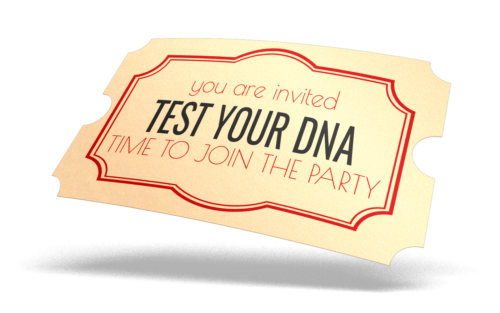
This got me thinking though, who are those people who haven’t tested? And why not? One category of people sans DNA test are those who have full pedigree charts. I have heard many of them say that they don’t see the need to do DNA testing since they have most of their lines “way back.” To those with the blessing of ancestors who kept better records than mine, I am offering four reasons why you should RSVP to your invitation to DNA test.
- Record. First and foremost, your DNA is a record. Just as you have obtained birth certificates and marriage licenses for your ancestors, your DNA is a unique record. It does represent you and your family in a way that no other record can. It is a document of your genetic history, and should be preserved. Further, while you may doubt the ability of your DNA to shed light on your current genealogy, don’t underestimate the contribution it might make in the future.
- Second Cousins. And third cousins, and fourth cousins, etc. Having your DNA tested means you can see a biological connection between you and other relatives that have had tested. For many, the idea of meeting or forming relationships with distant cousins is not appealing. But even if you have no intention of attending DNA family reunions or even in corresponding with these relatives, there is something reassuring about seeing them there on your match list. There is a certain thrill that comes with recognizing the connection between you and someone else. A connection that may not add any new names to your tree, but it helps you feel a deeper connection to your ancestor, and a greater appreciation for your biology.
- Verify. Which brings me to the next point. Seeing these cousins on your list can actually help verify the genealogy you have already collected and documented. It helps to reassure you that you have made the right steps along the way, and may help you gain additional resources about your relative through their descendants that you find on your match list. Resources that can help turn that ancestor from a name on a chart, to a story and a life worth preserving.
- Philanthropy. The last reason to go ahead and have your DNA tested is to help others. If you have been lucky enough to fill in most of the blanks on your tree, you can help others do the same by simply having your DNA tested. Your DNA provides a link to your tree that might be just what someone needs to overcome a brick wall in their family history.
So, if you have been hanging out on the outskirts of DNA testing because you feel like your tree is full enough without it, remember to RSVP to your invitation to be DNA tested, and join the party!
GENEALOGY GEMS BOOK CLUB: A FAMILY HISTORY MURDER MYSTERY!
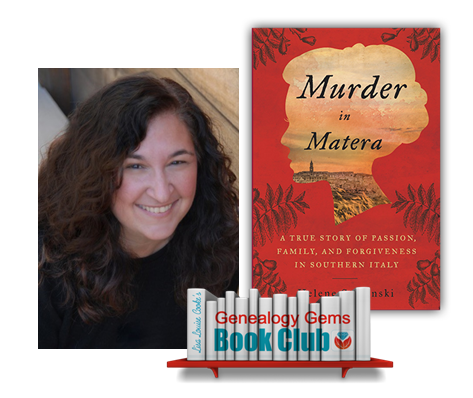
Murder in Matera: A True Story of Passion, Family, and Forgiveness in Southern Italy by journalist Helene Stapinski. A story of poverty and power, love, tragic decisions, and a courageous and desperate woman’s leap for a new life across the ocean.
Murder in Matera continues to unravel a past Helene explored in her fantastic first family history memoir, Five-Finger Discount: A Crooked Family History. Find a whole list of fabulous family history-inspired reading at the Genealogy Gems Book Club!

Genealogy Software
Lisa Louise Cooke uses and recommends RootsMagic family history software. From within RootsMagic, you can search historical records on FamilySearch.org, Findmypast.com and MyHeritage.com. RootsMagic is now fully integrated with Ancestry.com, too: you can sync your RootsMagic trees with your Ancestry.com trees and search records on the site.

Visit http://www.backblaze.com/lisa
Keep your family history research, photos, tree software files, videos and all other computer files safely backed up with Backblaze, the official cloud-based computer backup system for Lisa Louise Cooke’s Genealogy Gems. Learn more at http://www.backblaze.com/lisa.
GEM: VEHICULAR FORENSICS: Updated links, tips and resources
Here’s the original photo of my grandma next to her father’s car:

The original zoomed in image of the license plate:

The license plate with the “alternative light source” applied:

Since I first published this episode, iGoogle has gone away.
Websites for identifying old cars:
Hubcap Café.com: Collector Car Resources
Flickr group called Vintage Car Identification
From ItStillRuns.com: “Veteran cars were manufactured before 1903, vintage cars were made between 1903 and 1933, and classic cars are considered to be vehicles manufactured from 1933 until fifteen years ago.”
Learn more about ArchiveGrid in Premium Podcast episode 149 (Genealogy Gems Premium subscription required) and in this blog post: How to find original manuscripts and documents using ArchiveGrid.
The Genealogist’s Google Toolbox by Lisa Louise Cooke for Google searches and even YouTube:
“Take a ride in a 1928 Willys Knight made in, owned in and driven in Toledo, Ohio”
Forensic Files channel on YouTube
More updated resources:
“The Colorful History of California License Plates” in LA Magazine
TIP: Remember that you may be able to make great discoveries IN old photos with your photo editing software (even just with whatever free software is on your computer):
1. Open up the photo editing software
2. Open the photograph in question in the program
3. Use the trim feature to zoom in on the license plate?or whatever feature you want to focus on
4. Zoom in to make it easier to see
5. Try using both the Brightness and Contrast feature of your program in combination until you achieve a favorable result
6. Apply Auto Sharpen for further detail
Savvy tips to help identify old photos
Photo editing apps and software for family history
The Photo Detective by Maureen Taylor is your ultimate guide to identifying old objects in pictures to help you learn more about your family history.
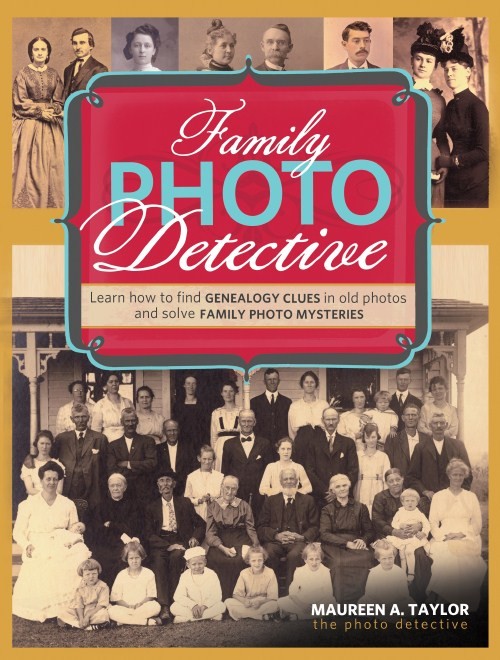
Get the book here

PRODUCTION CREDITS
Lisa Louise Cooke, Host and Producer
Sunny Morton, Editor
Diahan Southard, Your DNA Guide, Content Contributor
Hannah Fullerton, Production Assistant
Lacey Cooke, Service Manager
Resources
Download the episode
Download the show notes
by Lisa Cooke | Nov 13, 2018 | 01 What's New, Genealogy Gems Podcast |
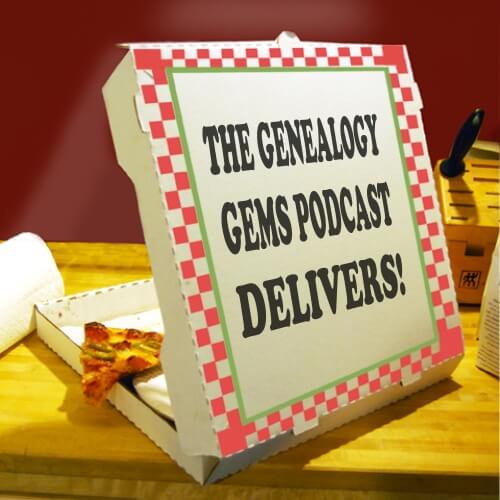
Pandora is now poised for podcast delivery!
Podcasts have always faced an obstacle: it just hasn’t been that easy to find them or listen.
After I launched The Genealogy Gems Podcast in early 2007, I spent most of my time trying to explain to potential listeners how to “subscribe” to the show. Along came the smartphone, and eventually podcast apps, and things got a little easier. In 2010 we launched our own Genealogy Gems Podcast app in hopes of improving the listener experience even more. That’s great for those tenacious enough to find us in the first place, but what about everybody else? Also though podcasts have experienced a huge surge in popularity thanks to the viral Serial podcast, 83% of Americans still aren’t listening on a weekly basis.
Pandora, the largest streaming music provider entered the game today and plans to change all that. And thanks to you, our loyal listeners, The Genealogy Gems Podcast has been selected by Pandora as part of their initial offering of podcasts!
Read below how this music giant is going to tap technology and human curation to recommend podcasts to those who are sure to love them. I’m sure that once Americans discover through Pandora that their family history is just waiting to be discovered, and that The Genealogy Gems Podcast is here to help them do just that, we’ll be welcoming many new listeners. Keep reading for all the details from Pandora. And, be sure to sign up for the early access offering here. You can expect to start seeing our show on Pandora sometime in December.
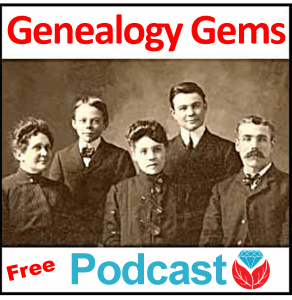
Thanks for listening friend!
Lisa Louise Cooke
PRESS RELEASE
OAKLAND, Calif.–(BUSINESS WIRE)–Pandora (NYSE:P), the largest streaming music provider in the U.S., today unveiled its podcast offering, powered by the Podcast Genome Project, a cataloging system and discovery algorithm that uses a combination of technology and human curation to deliver personalized content recommendations. Beginning today, Pandora will roll out beta access to select listeners on mobile devices. Those interested in early access to the offering can sign-up here, with general availability in the coming weeks.
“It might feel like podcasts are ubiquitous, but, eighty-three percent of Americans aren’t yet listening to podcasts on a weekly basis, and a majority of them report that’s because they simply don’t know where to start,” said Roger Lynch, Chief Executive Officer, Pandora. “Making podcasts – both individual episodes and series – easy to discover and simple to experience is how we plan to greatly grow podcast listening while simultaneously creating new and more sustainable ways to monetize them.”
Similar to how its namesake the Music Genome Project has helped Pandora become the best and easiest way to discover music online since 2005, the Podcast Genome Project recommends the right podcasts to the right listeners at the right time, solving the questions, “is there a podcast that’s right for me?” and “what should I listen to next?” It evaluates content based on more than 1500 attributes – spanning MPAA ratings, timely and evergreen topics, production style, content type, host profile, etc – and listener signals including thumbs, skips and replays. It also utilizes machine learning algorithms, natural language processing, and collaborative filtering methods for listener preferences. And, similar to the Music Genome Project, the Podcast Genome Project combines these techniques with our expert in-house curation team to offer episode-level podcast recommendations that reflect who you are today and evolve with you tomorrow.
“With the introduction of podcasts, listeners can now easily enjoy all of their audio interests – music, comedy, news, sports, or politics – on Pandora, the streaming service that knows their individual listening habits the best,” said Chris Phillips, Chief Product Officer, Pandora. “The Podcast Genome Project’s unique episode-level understanding of content knows exactly what podcast you’ll want to discover next, and will serve it up through a seamless in-product experience that is uniquely personalized to each listener and will continue to grow with their tastes over time.”
At launch, Pandora has partnered with top-tier publishers including APM, Gimlet, HeadGum, Libsyn, Maximum Fun, NPR, Parcast, PRX+PRI, reVolver, Slate, The New York Times, The Ramsey Network, The Ringer, WNYC Studios, and Wondery, and will continue to feature existing podcast content including Serial, This American Life and Pandora’s original Questlove Supreme, with many more to come in the future. These partnerships introduce hundreds of popular podcasts across a wide variety of genres including News, Sports, Comedy, Music, Business, Technology, Entertainment, True Crime, Kids, Health and Science, offering inspiring audio experiences for a variety of diverse interests.
ABOUT PANDORA
Pandora is the world’s most powerful music discovery platform – a place where artists find their fans and listeners find music they love. We are driven by a single purpose: unleashing the infinite power of music by connecting artists and fans, whether through earbuds, car speakers, live on stage or anywhere fans want to experience it. Our team of highly trained musicologists analyze hundreds of attributes for each recording which powers our proprietary Music Genome Project®, delivering billions of hours of personalized music tailored to the tastes of each music listener, full of discovery, making artist/fan connections at unprecedented scale. Founded by musicians, Pandora empowers artists with valuable data and tools to help grow their careers and connect with their fans.
www.pandora.com| @pandoramusic | www.pandoraforbrands.com | @PandoraBrands | amp.pandora.com
by Lisa Cooke | Aug 31, 2011 | images, Research Skills
“Mama arrived with 4 year old Martha gripping her hand tightly. She said she looked feverishly around for Papa, and spotted him across the room. She ran to meet him and gave him a kiss, which she normally would never have done in public!”
That was the scene my Grandma described as Louise and Gustaf reunited near a wooden column outside the Registry Room at Ellis Island aptly known as “The Kissing Post.” Many public displays of affection took place there after long journeys across the ocean.
Approximately 12 million immigrants were processed through Ellis Island between 1892 and 1954. It seems like only yesterday that the long dilapidated buildings were finally restored and reopened to the public. They have become one of the most popular tourist destinations in New York City, welcoming over 35 million visitors to date.
This month marks the 20th Anniversary of the Immigration Museum at Ellis Island which first opened on September 10, 1990.
According to a recent Ellis Island press release , “Just half a mile from the Statue of Liberty in New York Harbor, the museum’s exhibits highlight the growth of America during the peak immigration years of 1880-1924. The galleries illustrate the Ellis Island immigrant reception process, the immigrants’ arrival and settlement throughout the United States and feature their “Treasures From Home” – the cherished personal objects, photographs and papers they brought with them from their homelands. And the American Immigrant Wall of Honor® celebrates the immigrant experience with the inscription of the names of over 700,000 individuals and families who have been honored by their descendants.”
Of special note is the Ellis Island Oral History Archive, which was created by the Foundation and contains the reminiscences of over 1700 individuals who either immigrated through or worked at Ellis Island during its heyday as the country’s largest immigration processing center. If you are lucky enough to visit in person, you can listen to excerpts from these oral histories through the museum’s popular audio tour. You’ll walk the corridors vividly reliving the immigrant experience as if you were a “new arrival.”
If an in-person trip is not on your horizon any time soon, don’t fret. More than 1,700 first-hand life story audio recordings of Ellis Island immigrants are now available online for the first time free at Ancestry.com.
“As immigrants created new lives in the U.S., the stories of their homelands and their remarkable journeys to America were often lost,” said Christopher Tracy, senior vice president of global content for Ancestry.com. “We are thrilled to offer people the opportunity to hear the voices of their ancestors sharing stories of their lives.”
The oral histories were originally recorded by the National Park Service starting in the 1970s, and contain first-hand accounts recalling the lives these immigrants left behind, their reasons for leaving and their incredible and often-trying journeys to America. In addition to oral histories from immigrants, the collection also includes recordings from former Ellis Island/Statue of Liberty workers, and military personnel who were stationed on Ellis Island.
“To our family it is important that we in the U.S. know the origin of the people who came to this country, settled here and made it what it is today. It makes us very proud to know that our mother was part of this,” said Yvonne Rumac, daughter of oral history participant Estelle Belford, who immigrated to the United States from Romania via Ellis Island in 1905.
And if you are interested in learning more about your own immigrant ancestors here are some resources for you:
(Comprised of more than 170 million records, the Ancestry.com U.S. Immigration Collection includes lists of passengers who immigrated by ship to America between 1820 and 1960, including those who came through Ellis Island; more than 7 million citizenship and naturalization records; border crossings, passport applications and more to help reconstruct our ancestors’ journeys and early lives in America. Ancestry.com has also added nearly 2 million new U.S. naturalization record indexes.)
The FamilySearch Wiki
A brain trust of some of the best researchers out there, the FamilySearch Wiki allows you to search on keywords to learn more about a vast array of topics including immigration. Much of the information comes from the experts who work at the Family History Library in Salt Lake City. You get the benefit of their immigration research knowledge from the comfort of your own home.
Stephen P. Morse’s One Step Pages
If your search at the EllisIsland.org website doesn’t retrieve your ancestors head on over to Stephen Morse’s One Step Pages. There you will find dozens of links to search resources including the Ellis Island Gold Form for arrivals between 1892 and 1924. Even the folks at Ellis Island refer researchers to Morse’s site. Listen to my interview with Stephen Morse on Genealogy Gems Podcast episode #10
Family History: Genealogy Made Easy Podcast Episodes on Immigration and Naturalizaton
Genealogist Steve Danko covers immigration and naturalization in depth in episodes 29, 30, and 31. Steve even offers up some little known tips about deciphering some of the crytic notes researchers often find on passenger lists.

 Italy – Civil Registration
Italy – Civil Registration Keep up with genealogy news from around the world with Lisa Louise Cooke’s FREE Genealogy Gems weekly e-newsletter. You’ll get a free Google Research e-book as a thank-you gift when you do. From this page (or any other on this website), just enter your name where it says “Sign up for the free email newsletter” and click GO.
Keep up with genealogy news from around the world with Lisa Louise Cooke’s FREE Genealogy Gems weekly e-newsletter. You’ll get a free Google Research e-book as a thank-you gift when you do. From this page (or any other on this website), just enter your name where it says “Sign up for the free email newsletter” and click GO.






















